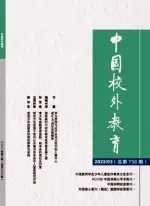Curriculum Analysis
◆Xu X iaoying
(China AgriculturalUniversity)
Curriculum Analysis
◆Xu X iaoying
(China AgriculturalUniversity)
The English as a Second Language(ESL)Curriculum for grades K-12 isa scope thatbuilds and develops linguistic proficiency for studentsbetween the agesof six and 21 years.The ESL professionals defines ESL students as those studentswho are non-native English speakers and whom ayorm ay no thave English proficiency.
English asa Second Language(ESL),Them ission of ESL,content-based approach
"ESL CURR ICULUM K-12"was created by ESL Comm ittee of Kennett Consolidated School District(KCSD)and was adop ted on May 13,2002,in Pennsy lvania,U.S.A.The English asa Second Language(ESL)Curriculum fo rgrades K-12 is a scope that builds and develops linguistic proficiency for students between the agesof six and 21 years.The ESL professionalsdefines ESL students as those studentswho are non-native English speakersandwhomay or may not have English proficiency,butw ho have had a certain levelof hom e language literacy through taking full-time education in theirown languages.
Them ission of ESL grogram atKCSD is to provide supportand intensive instruction in English and Am erican cu lture to Non-and Lim ited English Proficient students thatw illenab le them to becom e successfulin them ainstream classroom,the schoo lenvironment,and the community at large.
Specifically speaking,the scope and sequence isbuiltupon national TESOL Standards and Pennsylvania’sA cadem ic Standards for Reading,Writing,Speaking,and Listening.The follow ing specific ob jectives further subdivided intomore specific language skills and language uses.
A t"using English to comm unicate in social settings"level func tion,standard 1:studentsw ill use English to participate in social interactions;standard 2: studentsw ill interact in,through,and with spoken and w ritten English for personal expression and en joyment;standard 3:studentswilluse learning strategies to extend their comm unicative competence.At"using English to achieve academ ically in all contentareas"level,standard 1:studentsw ill use strategies to extend their communicative competence;standard 2:studentsw illuse English to obtain,process,construct,and provide sub jectm atte info rm ation in spoken and w ritten form;standard 3:studentsw illuse appropriate learning strategies to construct and app ly academ ic know ledge.At"using English in socially and culturally appropriate ways"level,standard 1:studentswill use the appropriate language variety,register and gen re according to audience,purpose and setting; standard 2:studentsw illuse nonverbal communication appropriate to audience, purpose,and setting;standard 3:studentsw ill use appropriate learning strategies to extend their sociolinguistic and sociocu ltural competence.
Consequently,This curriculum statement is based on the fo llow ing approaches about language and second language learning and teaching.JustasRichard and Rodgers(2001)mentioned some of the characteristics of communicative view of language,we know that the communicative,or functional view of language is the view that language isa vehicle for the expression of functionalmeaning,for learning conten t,and is to bring together know ledge,language,and thinking skills.Using language to acquiring information and students’needs for leaning a second language ismore emphasized than the grammatical characteristics,although these are also included.The specific purpose of languagem ay be "academ ic,vocational,social,or recreationalbut itgivesdirection,shape,and ultimatelymeaning to discourse and texts"(R ichard and Rodgers,2001,p. 208).
Content-based approach that in tegrates con ten t know ledge, linguistic know ledge,practice,and culture underlie this curriculum.Second language learning invo lves learning English in the contextof a new culture.Studentsneed to learn how to interactm eaningfu lly and appropriately in that language and culture.Arich variety of alternative kindsof content chosen relates to students’real needs.Studentsmay use their know ledgeof theirnative languagesand cultures to develop an understanding that encompasses the new culture.This curriculum is the case of an academ ically focused program:
"The language curriculum is based directly on the academ ic needs of the students and generally follow s the sequence determ ined by a particu lar subject matter in dealingwith the language problem swhich studentsencoun ter"(B rinton etal.,1989:2)
Teachersare advised in this curricu lum to keep contextand comprehensibility foremost in theirp lanning and presentations.They are responsible for selecting and adap ting authentic m aterials for the future use in the class;they becom e studentneedsanalystsbeforeorduring thewhole learning process;and they have to create truly learner-centered classroom s.Studentswill supporteach other in collaborativemodesof learning.Learners them selvesm ay be sources of content and jointparticipants in the selection of top ics and activities.
This curriculum uses a top ical syllabuses(B rown,1995)and a functional -notional syllabus(Yalden,1987).The top ical syllabus is organized around themesor top ics such as"survival","school""clothing",and"food"etc.. Those top ics are sequenced on the basisof their perceived importance(B rown, 1995).Theparamount things for the second language newcom ersare gradated for students learning step by step.A lso,functional-notional syllabus is used under some top ics.Some content focuses are organized around language functions like greetings,introductions,mannerwords,and personal information used etc.,and are logically organized or arranged in a sequence around language functions. Such as in content top ic"survival",the language functions are sequenced as greeting peop le,introducing someone,seeking information,interrup ting,changing top ics,and saying good bye.
Comm unicative language teaching uses almost any activity that engages learners in authentic communication.There are twomajor activity types used in this curriculum:functional communication activities:ones aimed at develop ing certain language skills and functions,butwhich involve communication.The second type concerns social interaction activities,such as conversation and discussion sessions,dialoguesand role-plays,interview and play performance etc. consequently,those exercises,activities and pedagogicalmaterials(such as student-centered books,magazines,internet sites,graphic organizers,audiovisuals,manipu latives,and guest speakers,etc.)can contribute to the achievem entof the stated comm unicative competence.
Fourmajor processes interact simultaneously during second language acquisition in a schoolenvironment:linguistic,academ ic,sociociltural,and cognitive process(Co llier,1995).It is difficult to summ arize the procedure in comm unicative c lasses because of thew ide variety of activities used in individual,pairor whole classwork,but it is definitely student-centered procedures.
In order to review and upgrade texts and resources to support ESL students’learning and to ensu re their relevance to the schoo lpopu lation and other curriculum areas,educators emp loy several assessmentprocedures in this curriculum to suitobjectives,situations,or students.Both oralandw ritten strategiesare used. Assessm ent techniques include:inform al interaction and observation,groupreports and tests,class tests,self-assessment and peer assessment reports,records of conferencing,comparison of students ability to ESL scales outcome statements,students proficiency tests, moderation of studentwork samp les,self-evaluation,etc..
[1]B rinton,D.M.,M.A.Snow,andM.B.Wesche.(1989).Content -Based Second Language Instruction.New York:Newbury House.
[2]Yalden,Janice.(1987).The communicative syllabus:Evolution,design and imp lementation.Englewood C liffs,NJ:Prentice-Hall.
[3]Collier,V.P.(1992).A Synthesisof Studies Exam ining Ling-Term Language Mino rity Student Data on Academ ic Achievem ent.Bilingual Research Journal,16,1&2,187-212
[4]Richards,J.C.&Rodgers,T.S.(2001).Approaches and Methods in Language Teaching.

